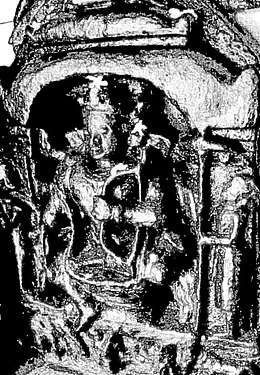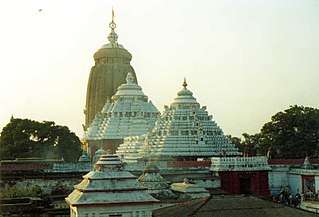Anantavarman Chodaganga
| Anantavarman Chodaganga Deva | |
|---|---|
| Gangeswara | |
| Reign | 1077 - 1147 A.D |
| Successor | Jatesvaradeva or Ekajatadeva (1147–1156 A.D) |
| Spouse | Jala Mahadevi, Choda Mahadevi, Kalinga Mahadevi, Lakshmi Mahadevi, Yarukamma Mahadevi, Kalyanadevi, Kosanadevi, Lavanyavati Devi, Lilavati Devi, Jayamagonda Chodidevi, Kali Satyabhama, Lokambika, Marajabamidevi, Dennava Mahadevi, Pachari Mahadevi, etc. |
| House | Eastern Ganga Dynasty |
| Father | Devendravarman Rajaraja Deva I |
| Mother | Rajasundari (Chola princess) |
| Religion | Hinduism |

Anantavarma Chodaganga Deva (Odia: ଅନନ୍ତବରମଣ ଚୋଡ଼ଗଙ୍ଗ ଦେବ) was a ruler of the Eastern Ganga dynasty which ruled the southern part of Kalinga, India. He was the son of Devendravarman Rajaraja Deva I and Rajasundari, the daughter of Virarajendra Chola. The Chola king Kulothunga Chola I of the Chola dynasty was his uncle. However, historian S.N. Sen states that Anantavarman was the maternal grandson of Kulottunga. The Jagannath Temple at Puri was rebuilt in the 11th century[1] atop its ruins by Anantavarman Chodaganga.[2] [3]
King Chodaganga was originally a Shaivite from Srimukhalingam who became a Vaishnava under the influence of Ramanuja when he visited Jagannath Puri. Despite Kulothunga Chola I being his maternal uncle, it did not stop the Chola sovereign from burning Anantavarman's empire. Historians propose that it was probably because the king failed to pay his rent for two consecutive years. He was ousted by Kulothunga's general Karunakara Thondaiman and this victory is detailed in the Tamil classic Kalingattupparani. Monarchs from this region of the subcontinent regularly assumed the title Chodaganga Deva throughout the ancient and medieval periods to allude to their Chola and Ganga heritage
From various inscriptions it is known that King Anantavarman Chodaganga Deva established the present temple some time near the end of the eleventh century. A copper plate inscription made by King Rajaraja III found on the Tirumala Venkateswara Temple near the north entrance states that Jagannath temple was built by Gangesvara, i.e., Anantavarman Chodaganga Deva.
Later, King Ananga Bhima Deva II (1170–1198) did much to continue the work of Chodaganga Deva, building the walls around the temple and many of the other shrines on the temple grounds. He is thus often considered one of the builders of the temple. He also did much to establish the regulations around the service to the Deity.

A scion of this dynasty made rich donations to the Koneswaram temple, Trincomalee on Puthandu, 1223 CE in the name of King Chodaganga Deva. Shortly afterwards, the Konark temple was constructed in Odisha.
Forts built
Temples built
Chodaganga Deva has built numerous temples in Odisha and Andhra Pradesh[4]
In Odisha
- Jagannath Temple, Puri
- Gundicha Temple, Puri
- Chintamaneswara, Bhubaneswar
- Kedareswara, Bhubaneswar
- Siddheswara, Bhubaneswar
- Rameswara, Bhubaneswar
In Andhra Pradesh
- Perumal Temple, Ghara-Kona (Tekkali)
- Siddheswara, Ronanki
- Nilakantheswara, Bobbili
- Chodaganga Madhava, Dharamavaram Village
- Madhava Temple, Vizianagaram Taluk
Sources
- Sastri, K. A. Nilakanta (2000) [1935]. The Cōlas. Madras: University of Madras. pp. 322–323.
References
- ↑ Sen, Sailendra (2013). A Textbook of Medieval Indian History. Primus Books. pp. 36–37. ISBN 978-9-38060-734-4.
- ↑ Cesarone, Bernard (2012). "Bernard Cesarone: Pata-chitras of Orissa". asianart.com. Retrieved 2 July 2012.
This temple was built between approximately 1135-1150 by Codaganga
- ↑ "Chodaganga Deva". indiadivine.org. 2012. Retrieved 2 July 2012.
Chodaganga Deva (1078-1150), the greatest of the Ganga kings, built a new temple on the ruins of the old one
- ↑ "Anantavarma codaganga deva and his times A D 1078 to 1147, Chapter 9, Art and Architecture" (PDF). www.shodhganga.inflibnet.ac.in. pp. 292–303. Retrieved 12 October 2018.